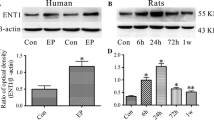Abstract
The mechanism of action of many anticonvulsive agents is to increase the function of the GABAergic system. Inhibition of GABA-Transaminase (GABA-T), the degradative enzyme for GABA, increases GABA levels in the brain. In this study, antisense oligodeoxynucleotides (ASO) targeted at the start codon region of GABA-Transaminase mRNA were used to modify seizure activity. Mice were treated, by intracerebroventricular injection, with antisense oligos or appropriate controls. At various times after treatment, the animals were challenged with cocaine (70 mg/kg, i.p.) and observed for seizure activity. At 15 hours after treatment, 1.152 and 1.44 nmol antisense oligo blocked cocaine-induced seizures. There was no effect of antisense oligo 8 or 36 hours after treatment. In addition, treatment with 7.2 nmol antisense oligo prevented pentylenetetrazol-induced seizures. These data demonstrate the modulation of seizure threshold using antisense oligodeoxynucleotides to GABA-T.
Similar content being viewed by others
REFERENCES
Abel, M.S. and McCandless, D.W. (1992). Elevated gamma-aminobutyric acid levels attenuate the metabolic response to bilateral ischemia [see comments]. J. Neurochem. 58:740–4.
Braestrup, C., Nielsen, M., Honore, T., Jensen, L.H. and Petersen, E.N. (1983). Benzodiazepine receptor ligands with positive and negative efficacy. Neuropharmacology 22:1451–7.
Browne, T.R., Mattson, R.H., Penry, J.K., Smith, D.B., Treiman, D.M., Wilder, B.J., Ben-Menachem, E., Napoliello, M.J., Sherry, K.M. and Szabo, G.K. (1987). Vigabatrin for refractory complex partial seizures: multicenter single-blind study with long-term follow-up. Neurol. 37:184–189.
Brussaard, A.B. (1997). Antisense oligonucleotides induce functional deletion of ligand gated ion channels in cultured neurons and brain explants. J. Neurosci. Methods 71:55–64.
Gale, K. (1992). GABA and Epilepsy — Basic Concepts from Preclinical Research. Epilepsia 33:S3–S12.
German, S.P. and German, S.M. (1996). Microperfusion of picrotoxin in the hippocampus of chronic freely moving rats through microdialysis probes: a new method of inducing partial and secondary generalized seizures. J. Neurosci. Meth. 67:113–120.
Karle, J., Laudrup, P., Sams-Dodd, F., Mikkelsen, J.D. and Nielsen, M. (1997). Differential changes in induced seizures after hippocampal treatment of rats with antisense oligodeoxynucleotide to the GABAA receptor g2 subunit. Eur. J. Pharmacol. 340:153–160.
Karle, J. and Nielsen, M. (1995). Modest reduction of benzodiazepine binding in rat brain in vivo induced by antisense oligonucleotide to GABAA receptor gamma 2 subunit subtype. Eur. J. Pharmacol. 291:439–41.
Karle, J., Witt, M.R. and Nielsen, M. (1995). Antisense oligonucleotide to GABAA receptor gamma 2 subunit induces loss of neurones in rat hippocampus. Neurosci. Lett. 202:97–100.
Karle, J., Woldbye, D.P.D., Elster, L., Diemer, N.H., Bolwig, T.G., Olsen, R.W. and Nielsen, M. (1998). Antisense Oligonucleotide to GABAA Receptor g2 Subunit Induces Limbic Status Epilepticus. J. Neurosci. Res. 54:863–869.
Krnjevic, K.: Significance of GABA in Brain Function. New York: Wiley-Liss, Inc.; 1991
Krnjevic, K. and Schwartz, S. (1967). The action of gamma-aminobutyric acid on cortical neurons. Exp. Brain Res. 3:320–336.
Marley, R.J., Witkin, J.M. and Goldberg, S.R. (1991). Genetic factors influence changes in sensitivity to the convulsant properties of cocaine following chronic treatment. Brain Res. 542:1–7.
Matilainen, R., Pitkanen, A., Ruutiainen, T., Mervaala, E., Sarlund, H. and Riekkinen, P. (1988). Effect of vigabatrin on epilepsy in mentally retarded patients: a 7 month follow up study. Neurol. 38:743–747.
Miczek, K.A. and Weerts, E.M. (1987). Seizures in drug-treated animals [letter]. Science 235:1127–8.
Olsen, R.W. (1982). Drug interactions at the GABA receptor-ionophore complex. Annu Rev. Pharmacol. Toxicol. 22:245–77.
Peris, J., Jung, B.J., Resnick, A., Walker, P., Malakhova, O., Bokrand, Y. and Wielbo, D. (1998). Antisense inhibition of striatal GABAA receptor proteins decreases GABA-stimulated chloride uptake and increases cocaine sensitivity in rats. Mol. Brain Res. 57:310–320.
Piredda, S., Lim, C.R. and Gale, K. (1985). Intracerebral site of convulsant action of bicuculline. Life Sci. 36:1295–8.
Reith, M.E.A., Kim, S.S. and Lajtha, A. (1986). Structural requirements for cocaine congeners to interact with [3H]Batrachotoxinin A 20-a-benzoate binding sites on sodium channels in mouse brain synaptosomes. J. Biol. Chem. 16:7300–7305.
Sabers, A. and Gram, L. (1992). Pharmacology of Vigabatrin. Pharmacology & Toxicology 70:237–243.
Schousboe, A., Larsson, O.M. and Drogsgaard-Larsen, P.: GABA Uptake Inhibitors as Anticonvulsants. New York: Wiley-Liss, Inc.; 1991
Tunnicliff, G. (1990). Action of inhibitors on brain glutamate decarboxylase. Int. J. Biochem. 22:1235–41.
Tunnicliff, G.: GABA Aminotransferase Inhibitors as Potential Antiepileptic Agents. New York: Wiley-Liss, Inc.; 1991
Twyman, R.E. and MacDonald, R.L.: Antiepileptic Drug Regulation of GABAA Receptor Channels. 1991
Wang, K.G. (1988). Cocaine induced closures of single batrachotoxin-activated Na+ channels in planar lipid bilayers. J. Gen. Physiol. 92:747–756.
Zhang, R., Lu, Z., Zhang, X., Zhao, H., Diasio, R.B., Liu, T., Jiang, Z. and Agrawal, S. (1995). In vivo stability and disposition of a self-stabilized oligodeoxynucleotide phosphorothioate in rats. Clin. Chem. 41:836–43.
Zhao, T.J., Rosenberg, H.C. and Chiu, T.H. (1996). Treatment with an antisense oligodeoxynucleotide to the GABAA receptor gamma 2 subunit increases convulsive threshold for beta-CCM, a benzodiazepine "inverse agonist", in rats. Eur. J. Pharmacol. 306:61–6.
Author information
Authors and Affiliations
Corresponding author
Rights and permissions
About this article
Cite this article
Abel, M.S., Kohli, N. GABA-Transaminase Antisense Oligodeoxynucleotide Modulates Cocaine- and Pentylenetetrazol-Induced Seizures in Mice. Metab Brain Dis 14, 253–263 (1999). https://doi.org/10.1023/A:1020737125843
Issue Date:
DOI: https://doi.org/10.1023/A:1020737125843




